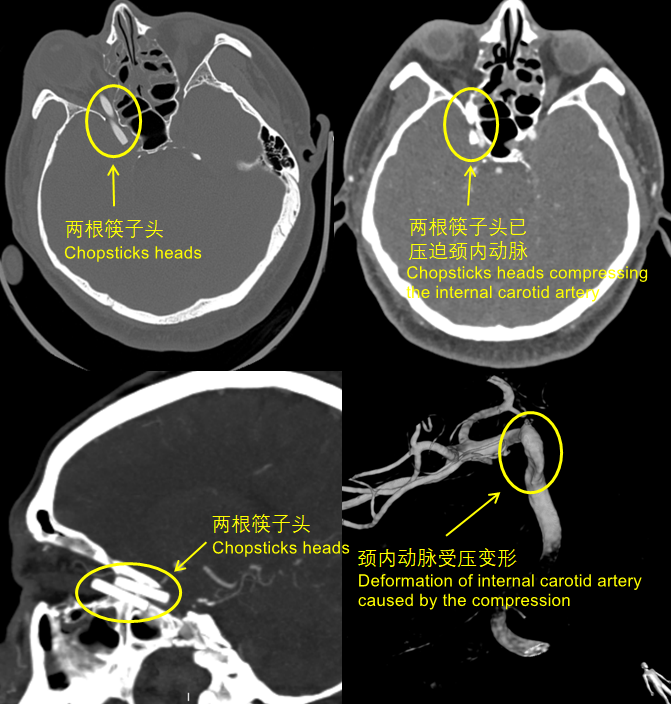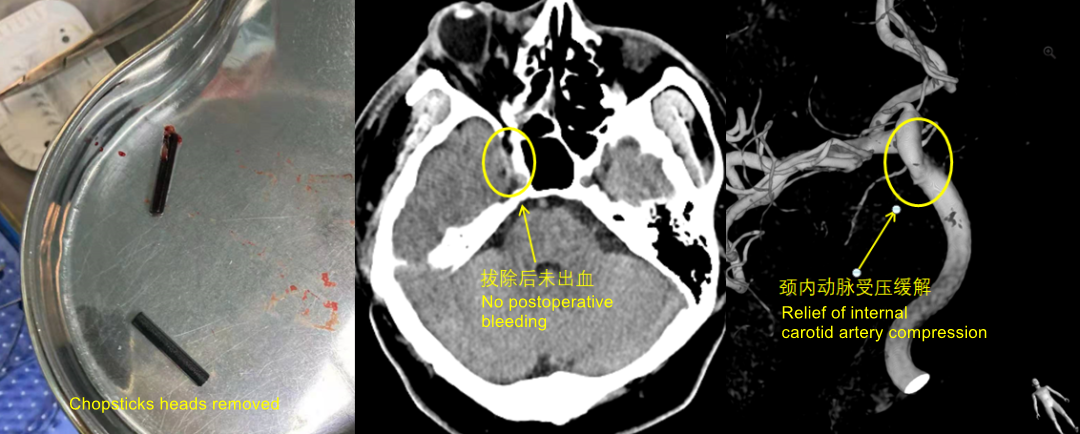
A Pair of Chopsticks in the Eye
Recently, a patient was presented in the SAHZU Emergency Center with a pair of broken chopsticks poked in his right eye. The patient was having an argument with other people in a restaurant when the accident happened, and he was also so violent that he pulled out the chopsticks immediately at the scene. But the chopsticks heads were broken off and left in the eye socket possibly due to the wrong angle of force, which put the patient in critical condition with excessive bleeding.

The patient has completely lost his vision of right eye at the time when associate professor of SAHZU Neurosurgery Dr. YAN Wei was examining him in the emergency room. It can be seen in the CT scan that most of the chopsticks heads remained in the eye orbit with the deepest part piercing through the superior orbital fissure and into the skull, and compressing the internal carotid artery.
Superior Orbital Fissure is a cleft or foramen in the skull that provides passage to many motor nerves to the extraocular muscles of the orbit. Damage to this cleft or foramen will have a high risk of impairing those nerves. Meanwhile, internal carotid artery is the largest intracranial artery, which, if ruptured, would lead to lethal consequences.
The patient's condition was very critical. On the one hand, the compressed internal carotid artery could cause either life-threatening hemorrhage at any time, or extensive cerebral infarction due to poor cerebral blood circulation. On the other hand, with the chopsticks heads left in the eye socket, the area could become infected over time and bacteria could enter the skull with serious consequences.
Three Surgical Approaches
The top priority for the patient is to remove the chopsticks heads. But the biggest challenge lies in the possible hemorrhage from internal carotid artery and the handling of it, otherwise patient life will be on the verge of death in a few minutes. In addition, it is also very challenging to locate the chopsticks heads in a swollen eye orbit.
The Department of Neurosurgery invited Emergency Medicine, Ophthalmology, Anesthesiology, Medical Imaging, Ultrasound Medicine and Intensive Care to have a multidisciplinary discussion. The conclusion is that the damage to patient's right eye is too severe and irreversible, and that the top priority remains to be removing of chopsticks while ensuring patient's safety.
From the degree of surgical invasion, surgical plans from three different approaches were schemed.
The transorbital approach: The transorbital approach along the original injury is the least invasive, but finding the chopstick head is more difficult due to swelling of the orbital tissue.
The transnasal approach: Transnasal surgery is the second most invasive, but carries a risk of cerebrospinal fluid leakage.
The open approach: It is easier to find the foreign body in an open surgery, but this approach is more invasive and increases the risk of infection.
And no matter which approach, the risk of arterial hemorrhage is real and needs to be prepared fully.
The team determined to perform the surgery in the hybrid operating room where endovascular intervention, microscopic craniotomy and endoscopic transnasal procedures are all applicable.
Before removing the chopsticks, a cerebral digital subtraction angiography was carried out to clarify the condition of intracranial arteries. Meanwhile, a guidewire catheter is placed to the site of compression, so in case of hemorrhage from arterial rupture, a balloon can be immediately placed through the vessel to stop the bleeding and vascular repair can be performed.
Fortunately, the transorbital plan worked well. Dr. YAN Wei and Dr. CHEN Ting of SAHZU Neurosurgery successfully extracted the chopsticks heads without massive bleeding, thanks to the aid of intraoperative ultrasound and other advanced devices. The immediate intraoperative angiography and CT scan showed no hemorrhage from the carotid artery, and less obvious indentation of the artery compression. Owing to the rich experience of the neurosurgery team and the state-of-the-art hybrid operating room, the patient avoided a complex and painful craniotomy.

Following the surgery, the anti-inflammatory treatment was given to the patient, and no obvious signs of infection were observed, and no pseudoaneurysm seen on the CTA one week after the operation. The patient was successfully discharged from the hospital. Although the vision of the patient’s right eye could not be restored, he has now returned to work.
About Neurological Acute and Critical Care at SAHZU
SAHZU ranks the fifth in the Neurosurgery in China. The sub-specialty of neurological acute and critical care has rich experience in severe brain trauma, brain hemorrhage, and postoperative complications, particularly in severe trauma, and has managed multiple penetrating brain injuries.
In the event of such an accident, patients are suggested to resort to nearest medical service immediately, and then transferred to an adequate medical center when condition allows. It is recommended that appropriate treatment measures be taken by a professional team after relevant examination and assessment, and any attempt to remove the foreign body before evaluation performed by non-medical personnel are highly unsuggested, in order to avoid aggravating the injury.
Author: YAN WEI | Reviewer: LI JING | Editor: LI JING | Source: SAHZU OFFICIAL WECHAT | Date:2022-04-19 | Views:![]()
![]()
![]()